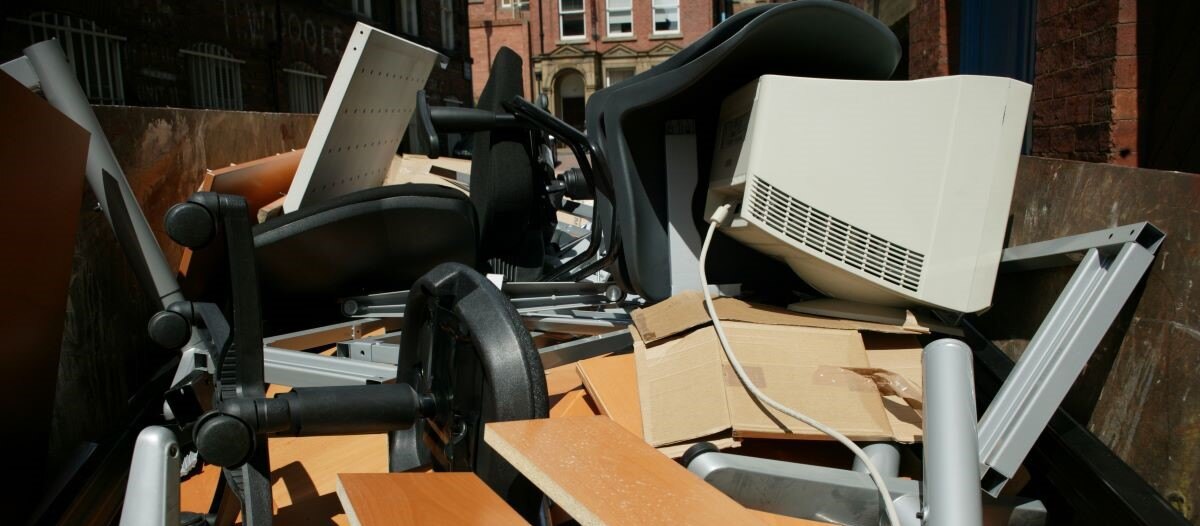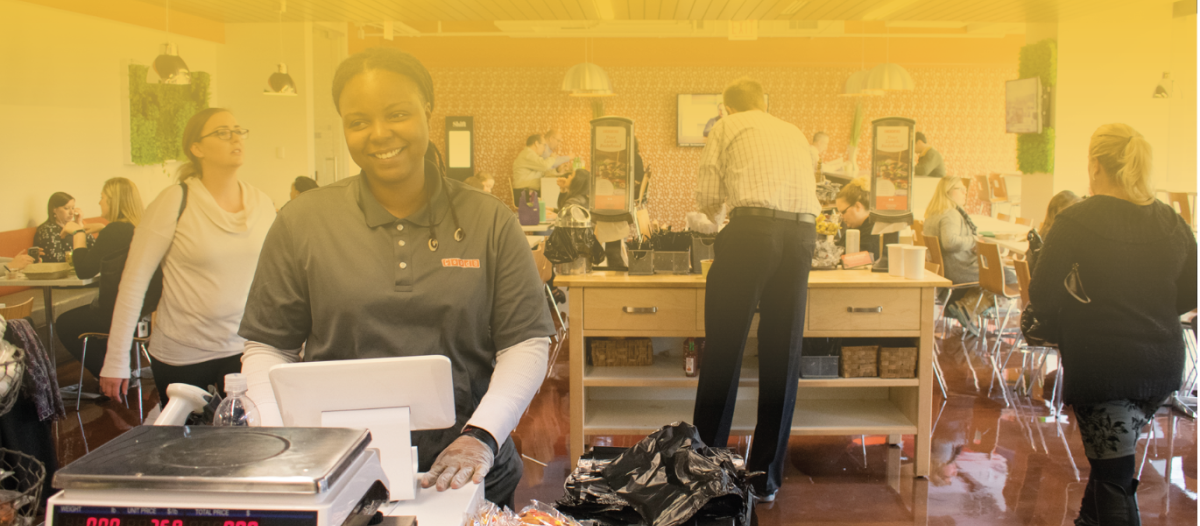Let's Talk Trash
5 ways to keep decommissioned furniture out of the landfill

According to United States EPA 2018 estimates, up to 17 billion pounds of office assets end up in U.S. landfills every year. With $20 billion worth of new products made each year in North America alone, it is easy to see there is a problem of planetary proportions.
Compounding that problem is the 2023 commercial real estate outlook indicating the challenges ahead. According to J.P. Morgan’s 2023 Commercial Real Estate Outlook, retail is at a crossroads, and the future of office space is unclear. Increasingly empty office buildings and high vacancy rates in every major city agree demonstrate this outlook. The outlook preducts a tough year for commercial real estate as recession becomes more likely.
“But we have to start somewhere, and furniture is a great place to focus,” said Joanna Friesen Toler, space design and construction manager at Amegy Bank in Houston, Texas, USA “Furniture is usually 25-30 percent of an interiors project cost, and it is a big problem for our industry and our planet.”
Friesen Toler recognized that problem early on in her tenure. She oversees approximately 1.2 million square feet of real estate for the company, including its furniture and decommissioning.
“I was shocked when I realized there weren’t many sustainable options available to decommission the furniture in the spaces I oversaw,” she said, “and that the cost of decommissioning wasn’t built into our overall project costs.”
Not knowing where to turn or what to do, she initially went the landfill route and vowed to do better.
Sustainable decommissioning — what it is & why it matters
Sustainable decommissioning of furniture embodies solutions that minimize or avoid furniture being sent to the landfill.
Five primary sustainable decommissioning strategies, listed in order of value to an organization, are reuse, reconfiguration, resale, donation and recycling.
Organizations often try to do the right thing by storing surplus furniture, but those warehouses often become above-ground landfills. Taking a proactive, multi-faceted and data-driven approach to furniture decommissioning and storage can reduce operating costs while also benefiting local communities. With the right leadership and communication for these efforts and strategies, sustainable decommissioning can become an integral and impactful part of facility operations.
Reuse — save the planet and money
Reuse is considered the use of existing non-systems products, such as task and lounge chairs, in new areas or new ways. This decommissioning strategy can result in the greatest impact and cost savings. Furniture budgets can be cut by more than half by creatively reusing assets.
How to get started? Right from the get-go, let all stakeholders know that the goal is to do the right thing for the planet. it is a surefire way to get buy-in from all corners of the organization and even get people pumped up to lend a hand. It also sets the stage for the idea that the best time to reuse furniture is always.
Here are some ways to find a second life for furniture:
- Repaint metal files and cabinets to match the new environment
- Reupholster soft seating for a fresh look
- Add height-adjustable legs to make an ergonomic workspace
- Create collaborative meeting spaces with lounge seating
- Cut down conference table tops and work surfaces for shelving and coffee tables
“Reuse and reconfiguration have really helped us save time and budget. It also helps us allocate our resources where they’re needed most, as many departments have different budgets and needs,” said Jenny McMath furniture lead for the Los Alamos National Laboratory near Santa Fe, New Mexico, USA.
Reconfiguration — Lego for furniture nerds
Reconfiguration is the breaking down of systems furniture, such as workstations and case goods, into all of its various parts and rebuilding in a new and different way — just like Lego.
Systems furniture by its very nature constantly changes too, and extending the life cycle of modular products increases ROI. By reconfiguring systems furniture, a company can achieve a new look and feel without incurring the expense of purchasing all new and reconfiguration also provides an opportunity to reduce footprint and restack departmental adjacencies.
One of the ways Friesen Toler and her team improved was through reconfiguration. They repurposed almost 14,000 square feet of furniture by redistributing workstations, private offices and ancillary furniture across different locations. The remaining ancillary pieces were relocated, upgraded and refreshed in various locations to avoid storage fees.
This effort avoided purchasing an estimated $500K of new furniture. Here’s how Friesen Toler and her team repurposed almost 14,000 square feet of furniture:
- 2,300 square feet went to their Arlington office
- 6,000 square feet went to their lease space
- 750 square feet went to their operations workroom, and
- 4,500 square feet went to their Houston bank branch
Resale — better than a garage sale
Resale is the sale of furniture items to outside individuals or companies. The seller generates income, the purchaser saves money, and the environment benefits from less waste in the landfill. Buying and selling preowned furniture extends the life cycle of existing workspace products and is a triple-win scenario.
Dollars and sense
The preowned office furniture market in the U.S. was valued at $12 billion in 2019 and is projected to reach $27 billion by 2027, according to the Business and Institutional Furniture Manufacturers Association.
“What companies paid initially for their furniture has no determination of its value on the secondary market. What other companies want now, and are willing to pay for, determines its value,” said Bill Adams, chair, Office Furniture Recyclers Conference.
It is a buyers’ market in the pre-owned furniture sector. Vacancy rates are incredibly high in commercial real estate as organizations are purposefully reducing their real estate footprint, which has flooded the market. FMs and real estate managers looking for spaces that are move-in ready with preowned furniture or looking to procure preowned furnishings will come out ahead.
Donation — creating karma currency
Donation is the gift of pre-owned furniture to other businesses, employees or individuals, creating goodwill and a tax deduction, all while benefiting the planet.
Think of this furniture decommissioning tactic as a gift that keeps on giving. Rehoming furniture that is no longer needed diverts waste from the landfill. Plus, it can help schools, nonprofits and cash-strapped organizations save precious funds.
Here are a few best practices for donating items, including:
- Establishing strong partnerships with vendors early on to facilitate logistics
- Considering popular items such as task seating and simple desks for donation because of their universal application and portable size
- Documenting processes and collect data to create success stories and impact statements
- It may seem obvious, but clean furniture and clear photos make a big difference when trying to attract interest in pre-owned furniture
Recycling — not just for plastic bottles
Recycling is the action or process of converting waste into reusable materials. While recycling is aspirational, it is currently recommended as a last resort in the sustainable decommissioning process. To support a more viable business case for recycling, further investment in technology and infrastructure is needed. However, when recycling is the only option, research local recycling facilities and guidelines to ensure proper handling and processing of materials.
Recycling centers and accepted materials will vary by location, but are commonly recyclable items in a typical office environment:
- Steel
- Desk frames
- Filing and storage cabinets
- Chair frames and bases
- Aluminum
- Chair bases
- Panel systems
- Table legs
- Glass
- Table tops
- Markerboards
- Plastics (PET, HDPE, PVC)
- Mesh textiles
- Poly chair seats
- Chair mats
- Electronics
- Panel systems electrical
- Conference table power/data
Think creatively and take responsibility
The solutions to sustainable decommissioning listed above can often be done independently or as a multi-faceted approach. For example, when outfitting or retrofitting a new office space, a combination of new and pre-owned products that still look fresh but lower furniture costs can help move a company toward its ESG goals.
This work is larger than one person, and one company can solve alone. FMs, designers, and owners must collaborate to drive new conversations, think creatively, ask for something different and take responsibility for the next generation.
Fast forward a year, and Friesen Toler describes her organization's sustainability progress as slow, steady and varied.
“[Amegy isn’t] to where we’re going just yet, but we’ve made some progress in the right direction,” she said. “We have repurposed and reconfigured furniture for multiple projects. We have purchased quality used furniture, saving us a lot of money and allowing us to keep our budgets lower, aka more easily approved. We were able to donate some ancillary furniture to Restore this year and are exploring an employee donation program. And we’re thinking more about assets’ end-of-life when we purchase new, which as a bonus, keeps our storage costs down.
“As facility owners and managers, it’s our responsibility to be good stewards of our real
estate and resources,” she said. “The planet doesn’t need all of us doing everything differently, it needs all of us doing one thing differently.”

Dianne Murata is the founding principal and accidental environmentalist at kimiko designs, an interior design firm specializing in all things furniture (except selling it). kimiko designs leads kimiko green, a community of industry experts, including Toyota North America, Sony Pictures Entertainment, Zions Bancorporation, Los Alamos, and Indeed, partnering to envision a better way to manage the furniture waste created by the built environment.
Read more on Real Estate , Sustainability and Emerging Topics
Explore All FMJ Topics









